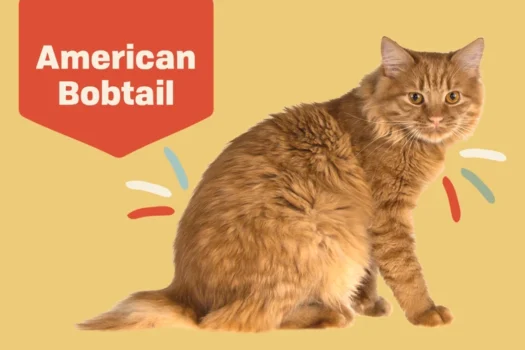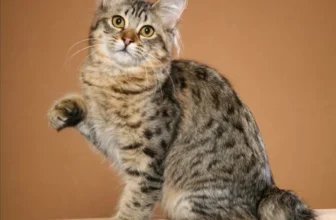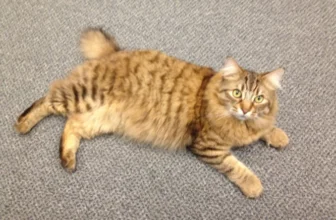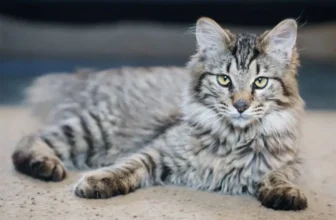As cat lovers, we are constantly mesmerized by the beauty and grace of our feline friends. One breed that has caught the attention of many is the American Bobtail. With its unique appearance and charming personality, the American Bobtail has become a beloved member of many households. But have you ever wondered about the history and evolution of the American Bobtail breed standard? In this article, we will take a closer look at the early years of the breed standard, the changes that have been made over time, and what the modern American Bobtail breed standard entails. So buckle up and let’s embark on a journey of discovery!
Early Years of the Breed Standard

As the American Bobtail breed began to gain popularity in the late 1960s and 1970s, efforts were made to create a breed standard that would establish its unique characteristics and traits. This proved to be a significant task for breeders, as the American Bobtail was a relatively new breed that had only just started to emerge in various regions of the United States. However, with the dedication and perseverance of key figures within the breeding community, a breed standard was eventually established and recognized by various organizations. In this section, we’ll go back to the early years of the American Bobtail breed standard and explore how it all started. To understand the breed’s origins better, read our article about the American Bobtail breeding history, and how the breed was developed.
Foundation of the American Bobtail Breed
The American Bobtail breed has a relatively short history, but it’s a fascinating one. The breed is believed to have originated from a random genetic mutation in a litter of kittens. This mutation resulted in a shortened tail, which made the cats stand out from other felines.
It is unclear when and where the first American Bobtail cat was born, but early breeders such as Mindy Schultz, Charlotte Bentley, and Marjorie Finlay are considered key figures in American Bobtail breeding.
Interestingly, the breed was not initially created with the intention of producing a show cat, but rather as a family pet. The breeders wanted to create a cat that was intelligent, playful, and affectionate, while also being adaptable to different living environments, from city apartments to country homes.
The other main goal was to create a cat that had a wild and exotic look, similar to that of a bobcat, hence the name “Bobtail”. This was achieved through the selective breeding of cats with naturally short tails and cats with traits such as large bone structure, broad skull, and lynx-like ear tufts.
While the original breeding program faced some challenges, such as the difficulty of producing cats with consistent physical traits and finding suitable breeding partners, breeders eventually established the American Bobtail breed as we know it today.
It’s worth noting that the American Bobtail breed is often confused with other short-tailed breeds such as the Japanese Bobtail, but the two have distinct differences in appearance and genetics. Bobtail cats also differ from cats with short tails, where tails can vary in length due to injury or genetics.
The foundation of the American Bobtail breed is a testament to the dedication and hard work of its breeders, who created a unique and beloved pet that continues to capture the hearts of cat lovers everywhere.
Breed Standard Creation and Recognition
During the creation of the American Bobtail breed standard, breeders set out to develop a cat with a wild look and easygoing nature. The breed was officially recognized by The International Cat Association (TICA) in the 1980s thanks to the efforts of several key figures in American Bobtail breeding. This recognition meant the breed could be shown in TICA cat shows and eventually led to the establishment of the breed standard.
The process of developing the breed standard involved a lot of deliberation between breeders. They had to decide on specific physical traits that the breed should possess as well as set guidelines for temperament and personality. The goal was to create a breed that was not only visually unique, but also had a great personality, making it a perfect pet for any household.
Creating the breed standard was not without its challenges, and some breeders felt that creating a breed with such a distinctive look and personality was difficult. However, the dedicated breeders kept working to ensure the American Bobtail breed was recognized and established.
The American Bobtail’s unique physical characteristics and personality traits are still being refined through genetic testing and continued breeding efforts to this day. While the breed has come a long way since its early beginnings, breeders are still working to overcome various challenges that arise with breeding such a distinctive cat.
One of the distinguishing features of the American Bobtail breed is its short tail. This has sometimes caused confusion with other breeds that have short tails such as the Manx. It’s important to note that the American Bobtail’s tail is not the same as the Manx’s. In fact, the American Bobtail’s short tail is a result of a dominant gene, not a lack of a tail like the Manx.
The recognition of the American Bobtail breed by a major cat association and the establishment of its breed standard was a significant step in the development of the breed. The breed standard helped to solidify the American Bobtail’s unique physical characteristics and temperament, making it a beloved and recognized breed in the feline world.
Early Breed Standards
The early breed standards for the American Bobtail were quite simple and straightforward, with a focus on the breed’s distinctive physical characteristics. One of the main requirements for the breed was a short tail, which could be straight or slightly curved, but should not exceed two-thirds of the length of a regular cat tail. The breed standard also called for large, expressive eyes that were either gold or yellow in color, and a stocky, muscular build that gave the cat a powerful appearance.
To be considered a true American Bobtail, a cat had to exhibit these physical characteristics as well as a friendly, outgoing personality. Bobtails were known for being playful and energetic, with a love for the outdoors and hunting. These qualities were prized by breeders and enthusiasts, making the American Bobtail a popular choice among cat lovers.
However, as the breed grew in popularity, so did the need for more detailed and comprehensive breed standards. In the 1990s, the American Bobtail began to undergo a revolution in their breed standards, with a focus on ensuring the breed’s health, temperament, and overall well-being.
Early Breed Standards for the American Bobtail:
| Physical Characteristics | Personality Traits |
|---|---|
| Short, straight or slightly curved tail | Friendly and outgoing |
| Large, expressive eyes (gold or yellow) | Playful and energetic |
| Stocky and muscular build | Love for the outdoors and hunting |
Today, the American Bobtail breed standard has evolved significantly, with a greater focus on health, temperament, and personality. Despite these changes, however, the breed’s distinctive physical characteristics and playful nature continue to make them a favorite among cat lovers around the world. If you want to learn more about the difference between the American Bobtail and other short-tailed cat breeds, check out our article on Bobtail vs Short Tails.
Changes to the Breed Standard
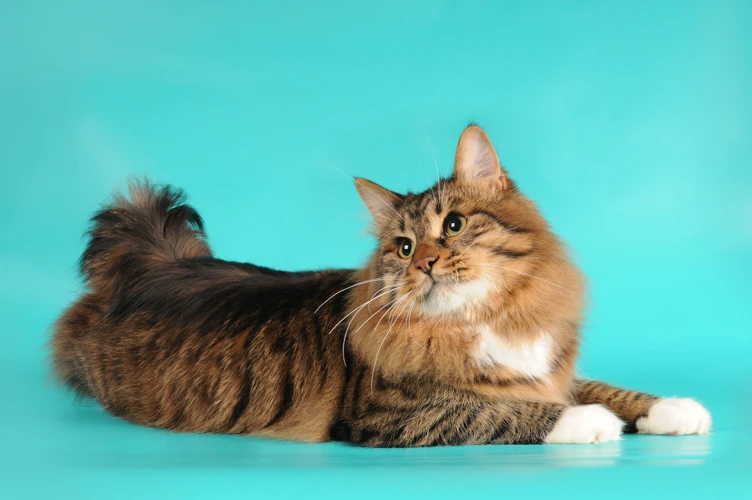
As with any breed of animal, the breed standard for the American Bobtail has undergone changes and revisions throughout the years. These adaptations have been made with the aim of refining the breed, improving its health and temperament, while also adhering to the breed’s original traits and characteristics. In this section, we will delve into the changes and evolution of the American Bobtail breed standard, exploring how it has transformed over time to become the remarkable breed it is today.
The 1990s: Revolutionizing the American Bobtail Breed Standard
In the 1990s, the American Bobtail breed standard underwent a major revolution. Breeders sought to improve the breed standard, specifically in regards to health and appearance. During this time, the American Bobtail was still a relatively new breed and did not have a clear set of breed standards to adhere to.
One of the main changes to the breed standard was the incorporation of stricter health requirements. Breeders began to focus on reducing the prevalence of certain health conditions, such as hip dysplasia and heart problems. To achieve this, breeding stock was carefully selected based on their health history and genetic screening.
Appearance was also a key focus during this time, with breeders working to refine the breed’s unique physical characteristics. The bobtail, which was once considered a defining characteristic of the breed, became more consistent across the breed. The coat pattern and color were also refined and became more uniform within the breed.
To showcase these changes, the breed standard was updated in 1998 by The International Cat Association (TICA). The updated standard highlighted the changes made to the breed and placed emphasis on the breed’s physical appearance and overall health. The new standard also included a detailed description of the breed’s personality and temperament, placing equal importance on the cat’s personality as well as its physical features.
The 1990s were a pivotal time for the American Bobtail breed standard. The changes made during this time helped to establish the breed as one with strict health and appearance standards that focus on both the physical and personality traits of the cat.
| Changes in the 1990s | Effects on the Breed |
|---|---|
| Focus on reducing health problems through genetic screening and selective breeding | Improved overall health of the breed and reduced prevalence of certain health conditions |
| Refinement of the bobtail characteristic and coat pattern/color | Increased consistency in appearance within the breed |
| Updated breed standard in 1998 by TICA | Established clear set of standards for breeders to adhere to and highlighted the importance of personality traits in addition to physical characteristics |
In short, the 1990s were a turning point for the American Bobtail breed standard, establishing clear guidelines for breeders to follow and improving the overall health and appearance of the breed.
The 2000s: Reflection and Refinement of the Breed Standard
During the 2000s, the American Bobtail breed standard underwent a period of reflection and refinement. Breeders and organizations focused on improving the health and appearance of the breed, as well as further defining the traits that best represent the breed. Some key developments during this time include:
- Refinement of Physical Characteristics: Breed standards were updated to clarify specific physical characteristics and encourage consistency in breeding. For example, the traditional “lynx tipping” on the ears was defined more precisely, with specific requirements for length and placement of the fur. The length and shape of the tail were also further refined to reflect the unique characteristics of the breed.
- Focus on Health: With a growing concern for the health of companion animals, especially purebred cats, breeders and organizations focused on minimizing genetic diseases and promoting overall wellness in the breed. Efforts were made to develop healthier breeding lines and encourage responsible breeding practices.
- Personality and Temperament: The American Bobtail is known for its friendly and outgoing personality. During the 2000s, breeders and organizations focused on promoting these traits and ensuring that they remained a key part of the breed standard. In addition to being physically healthy, American Bobtails were expected to be well-adjusted, affectionate, and sociable.
The 2000s were a time of reflection and refinement for the American Bobtail breed standard. Breeders and organizations worked to promote a healthy, well-adjusted breed with clear physical characteristics and a friendly, sociable personality. These efforts have helped to solidify the American Bobtail as a unique and beloved breed, with a bright future ahead.
The Present Day: Evolution of the Breed Standard
Over the years, the American Bobtail breed standard has continued to evolve, and today it is recognized as one of the most unique and remarkable cat breeds out there. The following are some aspects of the present-day evolution of the breed standard that are worth mentioning:
- Acknowledgment of Diversity: One of the most significant changes in the breed standard of today is the acknowledgment of the diversity of American Bobtail cats. The new standard recognizes that there is no one size fits all when it comes to the breed, and cats can come in different sizes, colors, and patterns.
- Emphasis on Health: With an increasing focus on pet health and wellness, the current breed standard places great emphasis on the health of the American Bobtail. Breeders are required to test cats for genetic diseases and maintain records to ensure the breed stays healthy and free from common genetic problems.
- Attention to Temperament: The breed standard now puts more emphasis on the American Bobtail’s temperament and personality. These felines are known for their friendly and affectionate nature, and the new standard aims to preserve these characteristics in the breed through controlled breeding and responsible cat care.
- Appearance: While the American Bobtail still retains its distinctive bobbed tail, there have been changes in its appearance criteria. The new standard allows for both short-haired and long-haired varieties, and there are provisions for a wide range of coat and eye colors. The head of the cat has been described as being moderately wedge-shaped with broad cheeks, and large, expressive eyes.
- Weight and Size: Finally, the current breed standard recognizes that American Bobtails can come in a range of sizes and weights. The ideal weight for a male American Bobtail is between 12 and 16 pounds, while for a female cat, it is between 8 and 12 pounds. However, this weight range is flexible, and cats that are healthy and proportionate in size can compete in cat shows.
The present-day American Bobtail breed standard is a testament to the hard work and dedication of breeders and cat lovers over the years. The breed standard emphasizes health, personality, and diversity, and for those looking to adopt a feline, the American Bobtail is an excellent choice.
The Modern American Bobtail Breed Standard
As the American Bobtail breed continued to evolve over the years, so did its standards. Today, the Modern American Bobtail Breed Standard outlines specific physical traits, temperament, and health requirements that all breeders and owners strive to uphold. Let’s take a closer look at the characteristics that make this breed so unique and beloved among cat enthusiasts.
Appearance and Physical Characteristics
The American Bobtail breed has a distinctive appearance, characterized by its short, bushy tail, broad head, and muscular build. This breed is considered medium to large with males weighing between 12-16 pounds and females ranging from 7-12 pounds. Let’s take a look at some of the breed standards that highlight the appearance and physical characteristics of the American Bobtail.
| Physical Feature | Standard |
|---|---|
| Head | The head is a broad modified wedge with a distinctive broad nose and strong chin. There should be a slight concave curve between the eyes. |
| Ears | The ears should be upright and expressive. |
| Eyes | The eyes are generally golden-yellow, but a green or blue-eyed American Bobtail is acceptable. The eyes should be almond-shaped and set at a slight angle. |
| Body | The body is medium to large, long and substantial with a broad chest and well-muscled legs. The back is straight and level. |
| Tail | The short, bushy tail should be between one-third and one-half the length of a normal cat tail. It can be straight, slightly curved or have bumps or kinks. It should be flexible, expressive and unique to the individual. |
| Coat | The American Bobtail has a shaggy, dense and plush coat that can be short or medium in length. The coat is water-resistant and can come in any color or pattern. |
It is important to note that while these standards outline the typical appearance and physical characteristics of the American Bobtail breed, there can be variations based on genetics, breeding and environmental factors. At the end of the day, the physical features that make each American Bobtail unique are what truly make them special.
Temperament and Personality
When it comes to the American Bobtail Breed Standard, temperament and personality are just as important as physical characteristics. This breed is known for being sociable, which makes them ideal pets for those who want a feline companion.
1. Sociable: American Bobtails are extremely sociable and love spending time with their humans. They crave attention and affection and enjoy being involved in family activities.
2. Intelligent: These cats are known for their intelligence and problem-solving skills. They are quick learners and enjoy interactive toys and games that challenge them mentally.
3. Active: American Bobtails are an active breed that loves to play and explore. They require plenty of physical activity to stay healthy and happy.
4. Affectionate: These cats are known for their affectionate nature and often form strong bonds with their owners. They enjoy cuddling and are often found napping next to their humans.
5. Independent: While American Bobtails love spending time with humans, they also maintain their independence. They are comfortable spending time alone and are not clingy or overly demanding.
6. Playful: American Bobtails have a playful spirit and enjoy interactive playtime with their owners. They are known for their love of toys and games and can often be found chasing after laser pointers or batting around toy mice.
The American Bobtail Breed Standard requires a cat with a friendly, sociable, and affectionate personality. These cats are intelligent and active but also maintain their independence. They make wonderful pets for those looking for an affectionate and playful companion.
Health and Care Requirements
When it comes to the health and care requirements of the American Bobtail breed, there are some important considerations to keep in mind. Here is a breakdown of some of the key things to know:
Health Considerations
The American Bobtail is generally considered to be a healthy breed with no major genetic health issues. However, like all cats, they can be prone to certain conditions. These may include:
- Obesity: American Bobtails love to eat and can be prone to overeating, so it’s important to monitor their food intake and keep them at a healthy weight through play and exercise.
- Urinary Tract Issues: Some American Bobtails may be prone to urinary tract issues such as crystals or blockages, so it’s important to monitor their litter box habits and seek veterinary care if necessary.
- Hypertrophic Cardiomyopathy: This is a heart condition that can affect cats of any breed, and may be more common in American Bobtails. It’s important to monitor your cat’s heart health and seek veterinary care if any issues arise.
Care Requirements
In terms of care, the American Bobtail is a low-maintenance breed that doesn’t require any special grooming beyond regular brushing to keep their coat healthy and tangle-free. They also typically have a robust immune system, so they don’t need to be vaccinated more often than other cats.
That being said, it’s important to provide your American Bobtail with a healthy and stimulating environment that encourages play and exercise. This can include providing plenty of toys, scratching posts, and climbing structures to keep your cat active and engaged.
It’s also important to keep your American Bobtail’s litter box clean and to feed them a healthy and balanced diet. Be sure to monitor their weight and adjust their feeding habits as needed to keep them at a healthy weight.
By following these simple health and care guidelines, you can ensure that your American Bobtail lives a happy, healthy, and fulfilled life as a beloved member of your family.
Conclusion
As we come to the end of our journey through the Evolution of American Bobtail Breed Standard, it’s time to reflect on all that we have learned. From the breed’s humble beginnings to its recognition as a unique and beloved breed, we’ve explored the changes and refinements that have shaped the American Bobtail as we know it today. But what does the future hold for this breed, and what does it mean for those who love and care for American Bobtails? Let’s delve into these questions as we wrap up our exploration of this fascinating breed.
The Future of American Bobtail Breed Standard
As with any breed standard, the American Bobtail breed standard is constantly evolving. While the breed characteristics have largely been set, there is always room for improvement in areas such as health, temperaments, and aesthetics. Breeders and organizations who focus on the American Bobtail breed standard are continuously refining their standards to create better cats overall.
Here are some potential areas of growth and evolution for the American Bobtail breed standard:
- Further Development of Health Standards: While the American Bobtail breed is a relatively healthy breed, there are still some health concerns that breeders will need to address in the future. As breeders become more knowledgeable about these concerns, they will be able to create healthier lines of American Bobtails.
- Evolution of Temperament Standards: American Bobtails are known for their friendly, outgoing personalities. As the breed evolves, breeders may strive to continue to emphasize these traits, while also potentially developing new personality standards for the breed.
- Refinement of Aesthetic Standards: Just as with any breed standard, the aesthetic standards of American Bobtails may continue to evolve over time. Breeders may focus on subtle changes to head shape, ear placement or tail length that will help the breed to be even more distinctive and recognizable.
- Recognition by More Organizations: While the American Bobtail has already been recognized by several major cat organizations across the world, there is still room for growth. As the breed becomes more popular, there is a good chance that more organizations will recognize the American Bobtail breed standard.
- Continued Focus on Breeder Education and Standards: Ultimately, one of the best ways to ensure the continued evolution and growth of the American Bobtail breed standard is for breeders to remain educated about the latest developments and trends in the world of cat breeding. By staying up-to-date with current knowledge and techniques, breeders can help ensure that this unique and beloved breed continues to flourish for generations to come.
As the American Bobtail breed standard continues to evolve, it’s likely that the breed will become even more beloved by cat fanciers around the world. With its distinctive looks and friendly personality, the American Bobtail is a truly one-of-a-kind breed that is sure to continue to capture the hearts of cat lovers far and wide.
What Does This Mean for American Bobtail Lovers?
For American Bobtail cat lovers, the evolution of the breed standard means a lot. With the refinement of the breed standard, American Bobtail cats are becoming even more unique and desirable as pets. Here are some of the key advantages and considerations that American Bobtail lovers should keep in mind:
| Advantages | Considerations |
|---|---|
| Improved breeding standards, such as increased emphasis on health and temperament, mean that new generations of American Bobtail cats are more well-rounded and suitable for adoption into households with children and other pets. | American Bobtail cats might still be relatively rare, which could make it harder to find breeders and affordable adoption options. |
| Evolving cat shows and competitions could offer more opportunities for American Bobtail owners to showcase their pets and breed knowledge. | New or updated breed standards might include additional health testing or requirements, which could raise the cost of breeding or adopting American Bobtail cats. |
| With continued efforts to refine the American Bobtail breed standard, this unique type of cat is likely to have a long, healthy future. | Cat owners who are interested in American Bobtail cats should be prepared to invest time, energy, and money into making sure their pets receive the best possible care. |
The evolution of the American Bobtail breed standard is a positive development for cat lovers who appreciate this unique and fascinating breed. By staying informed about changes to the breed standard and keeping up with best practices for cat care, owners can ensure that their American Bobtail cats thrive in any setting.
Frequently Asked Questions
What is the origin of the American Bobtail breed?
The American Bobtail breed originated in the United States, specifically in the southwest region, during the 1960s.
What makes the American Bobtail breed unique?
The American Bobtail breed is unique because of their short, stubby tails and wildcat-like appearance.
What are the early breed standards of the American Bobtail?
Early breed standards for the American Bobtail included a preference for longer tails and a lack of emphasis on their wildcat-like appearance.
How has the breed standard for the American Bobtail changed over the years?
The breed standard for the American Bobtail has changed dramatically since the 1990s, with more emphasis being put on their wildcat-like appearance and shorter tails.
What are the physical characteristics of the modern American Bobtail?
The modern American Bobtail is a medium to large-sized cat with a muscular build, a short, dense coat, and a distinctive wildcat-like appearance.
What is the temperament of the American Bobtail breed?
The American Bobtail is known for being a friendly, affectionate, and intelligent breed that is great with children and other pets.
What kind of health issues do American Bobtails face?
Like all breeds of cats, American Bobtails can face a range of health issues, including hip dysplasia, heart disease, and dental problems.
What kind of care requirements do American Bobtails have?
American Bobtails have relatively low maintenance care requirements, with regular grooming and dental care being the most important aspects of their care.
Can American Bobtails be trained?
Yes, American Bobtails are known for their intelligence and can be trained to do a range of tricks and behaviors.
Are American Bobtails a good fit for families?
American Bobtails are an excellent fit for families, thanks to their affectionate and friendly nature, as well as their ability to get along with children and other pets.

